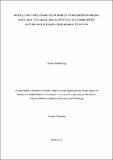Modelling the dynamics of rabies transmission among dogs and to human and livestock in communities within and around Addis Ababa, Ethiopia
Abstract
Rabies is one of the neglected tropical diseases that has persisted for centuries in Ethiopia, and
it is endemic within and around Addis Ababa. In this dissertation, we propose a deterministic
mathematical model with vaccination to study the dynamics of rabies transmission within and
around Addis Ababa. The model comprises human, dog and livestock populations and
formulated as a system of ordinary differential equations.
Basic reproduction number 0 R and effective reproduction number e R are computed using next
generation operator. For specified values of parameters 0 R and e R work out to be 2 and 1.6
respectively, which indicate the disease will be endemic. When 1 e R the disease-free
equilibrium 0 is globally asymptotically stable in a feasible region . When 1 e R there
exists one endemic equilibrium point which is locally asymptotically stable.
According to sensitivity analysis, the natural death rate of dogs 𝜇𝑑 , the annual birth rate of
dogs 𝜗𝑑 , dog-to-dog transmission rate 𝛽𝑑, and disease induced death rate of dogs 𝜎𝑑 are found
to be the most sensitive parameters of e R . Numerical simulations of our system show that
rabies transmission will increase within and around Addis Ababa, and will peak in 2026 and
2033 in human and livestock populations respectively. Applying 25% vaccination coverage for
livestock population will reduce the future infection by half. This study suggests that a
combination of interventions consisting of 60% of vaccination coverage in dog population,
15% culling of stray dogs, and reducing the annual crop of newborn puppies by 25% will
reduce the number of human and livestock infections by 70%, and the disease will be eradicated
from the community.

